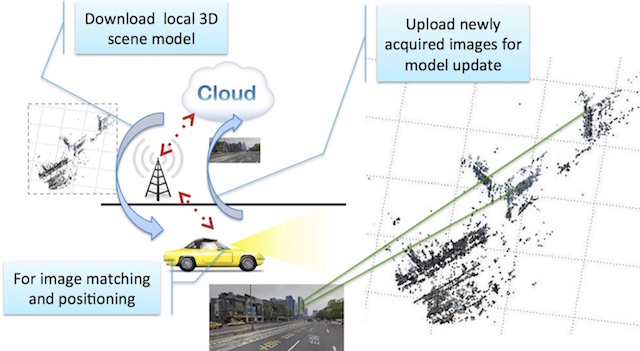Vision-Based Positioning for Internet-of-Vehicles
Vision-Based Positioning for Internet-of-Vehicles
Introduction
Ego-positioning aims at locating an object in a global coordinate system based on its sensor inputs. With the growth of mobile or wearable devices, accurate positioning has be- come increasingly important. Unlike indoor positioning, considerably less efforts have been put into developing high-accuracy ego-positioning systems for outdoor environments. Global Positioning System (GPS) is the most widely used technology implemented in vehicles. However, the precision of GPS sensors is approximately 3 to 20 meters, which is not sufficient for distinguishing the traffic lanes and highway lane levels critical for intelligent vehicles. In addition, the existing GPS systems do not work properly in urban areas where signals are obstructed by high rise buildings. Although several positioning methods based on expensive sensors, such as radar sensors and Velodyne 3D laser scanners, can achieve high accuracy, they are not widely adopted because of cost issues. Hence, it is important to develop accurate ready-to-deploy IoV approaches for outdoor environments.
We presents an algorithm for ego-positioning by using a low-cost monocular camera for systems based on the Internet-of-Vehicles (IoV). To reduce the computational and memory requirements, as well as the communication load, we tackle the model compression task as a weighted k-cover problem for better preserving the critical structures. For real-world vision-based positioning applications, we consider the issue of large scene changes and introduce a model update algorithm to address this problem. A large positioning dataset containing data collected for more than a month, 106 sessions, and 14,275 images is constructed. Extensive experimental results show that sub- meter accuracy can be achieved by the proposed ego-positioning algorithm, which outperforms existing vision-based approaches.
Overview of the algorithm
(a) training phase: images from passing vehicles are uploaded to a cloud server for model construction and compression;

(b) ego-positioning phase: SIFT features from images acquired on vehicles are matched against 3D models previously constructed for ego-positioning. In addition, the newly acquired images are used to update 3D models.

Result
Video on Youtube:http://www.youtube.com/embed/ZLjHGcqhbYA
Dataset
http://www.clarenceliang.com/dataset
Related Publications
[1] Kuan-Wen Chen, Chun-Hsin Wang, Xiao Wei, Qiao Liang, Ming-Hsuan Yang, Chu-Song Chen, and Yi-Ping Hung, “Vision-Based Positioning for Internet-of-Vehicles,” IEEE Transactions on Intelligent Transportation Systems, 2017.
[2] Kuan-Wen Chen, Chun-Hsin Wang, Xiao Wei, Qiao Liang, Ming-Hsuan Yang, Chu-Song Chen, and Yi-Ping Hung, “Vision-Based Positioning with Sub-meter Accuracy for Internet-of-Vehicles,” the 28th IPPR Conference on Computer Vision, Graphics, and Image Processing, Aug., 2015. (Best Paper Award)
Vision-Based Positioning for Internet-of-Vehicles的更多相关文章
- VIPS: a VIsion based Page Segmentation Algorithm
VIPS: a VIsion based Page Segmentation Algorithm VIPS: a VIsion based Page Segmentation Algorithm In ...
- Computer English Notes
Chapter 1 : About Computer Answer the following - Abbreviation LBS - Location-Based Services HTML - ...
- REST is not the Best for Micro-Services GRPC and Docker makes a compelling case
原文:https://hackernoon.com/rest-in-peace-grpc-for-micro-service-and-grpc-for-the-web-a-how-to-908cc05 ...
- 【AR实验室】ARToolKit之概述篇
0x00 - 前言 我从去年就开始对AR(Augmented Reality)技术比较关注,但是去年AR行业一直处于偶尔发声的状态,丝毫没有其"异姓同名"的兄弟VR(Virtual ...
- Socket网络编程一
1.Socket参数介绍 A network socket is an endpoint of a connection across a computer network. Today, most ...
- Python之路,Day8 - Python基础 面向对象高级进阶与socket基础
类的成员 类的成员可以分为三大类:字段.方法和属性 注:所有成员中,只有普通字段的内容保存对象中,即:根据此类创建了多少对象,在内存中就有多少个普通字段.而其他的成员,则都是保存在类中,即:无论对象的 ...
- Python之路第一课Day8--随堂笔记(socket 承接上节---网络编程)
本节内容 Socket介绍 Socket参数介绍 基本Socket实例 Socket实现多连接处理 通过Socket实现简单SSH 通过Socket实现文件传送 作业:开发一个支持多用户在线的FTP程 ...
- python走起之第八话
1. Socket介绍 概念 A network socket is an endpoint of a connection across a computer network. Today, mos ...
- Python学习路程day8
Socket语法及相关 socket概念 A network socket is an endpoint of a connection across a computer network. Toda ...
- 大规模视觉识别挑战赛ILSVRC2015各团队结果和方法 Large Scale Visual Recognition Challenge 2015
Large Scale Visual Recognition Challenge 2015 (ILSVRC2015) Legend: Yellow background = winner in thi ...
随机推荐
- Hadoop Ecosytem
There are a lot of Hadoop related projects which are open sourced and widely used by many componies. ...
- 牛客网Java刷题知识点之为什么HashMap不支持线程的同步,不是线程安全的?如何实现HashMap的同步?
不多说,直接上干货! 这篇我是从整体出发去写的. 牛客网Java刷题知识点之Java 集合框架的构成.集合框架中的迭代器Iterator.集合框架中的集合接口Collection(List和Set). ...
- TreeMap和TreeSet简单应用
建一个实体类并实现Comparable接口重写compareTo方法 public class pojo implements Comparable<pojo> { private int ...
- JavaScript中有var和没var的区别
Js中的变量声明的作用域是以函数为单位,所以我们经常见到避免全局变量污染的方法是 (function(){ // ... })(); 在函数内部,有var和没var声明的变量是不一样的.有var声明的 ...
- poj 1080 ——Human Gene Functions——————【最长公共子序列变型题】
Human Gene Functions Time Limit: 1000MS Memory Limit: 10000K Total Submissions: 17805 Accepted: ...
- C#字符串替换_无视大小写
C#里的string.Replace是不能无视大小写的. 首先想到的是正则表达式,在网上查了下,果然有用正则表达式配合一些逻辑运算,实现无视大小写的字符串替换方法.但是正则表达式的方法用起来很麻烦,实 ...
- Python 动态加载 Extension Manager Classes
看着看着发现了一个库:stevedore(http://stevedore.readthedocs.org/en/latest/managers.html),但是感觉文档做得不行啊,都没个tutori ...
- 一个基于Ionic3.x cordova的移动APP demo
项目地址如遇网络不佳,请移步国内镜像加速节点 前端技术: Angular4.x + ionic3.x + cordova 项目运行: git clone git@github.com:EasyTuan ...
- python调用其他文件的类和函数
在同一个文件夹下 调用函数 source.py文件: def func(): pass new.py文件: import source # 或者 from source import func 调用类 ...
- css 平行四边
在视觉设计中,平行四边形往往给人一种动感. 要生成一个平行四边形,只要通过css变形,就可做到: -webkit-transform: skewX(-45deg); 那么生成一个平行四边形的按钮呢?列 ...
